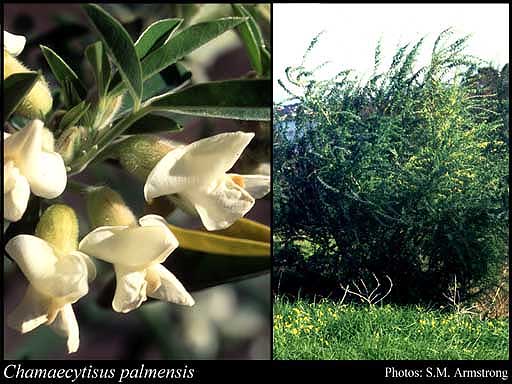- Reference
- Bot.J.Linn.Soc. 74:114 (1977)
- Conservation Code
- Not threatened
- Naturalised Status
- Alien to Western Australia
- Name Status
- Current
Erect shrub or tree, 0.7-6 m high. Fl. white-cream-yellow, Apr to Oct. White sand, grey sandy clay, lateritic loam. Alongside creeks and roads, disturbed areas.

Scientific Description
Erect, tree or shrub, spindly shrub (broom-like). Stems terete, not spiny, hairy; pustules or glands absent. Leaves or phylloclades clearly present, compound, alternate, not continuous with stem, 25-55 mm long, hairy, with simple hairs, flat with flat margins; margins entire; tubercles absent, palmately arranged, terminal leaflet present, sessile; pustules or glands absent. Stipules present but early deciduous ( only visible on youngest leaves ). Pedicel present, 3-5 mm long, hairy. Bracteoles present and persistent. Calyx 10-15 mm long, not accrescent, hairy, with simple hairs, ribless; pustules or glands absent. Corolla 15-25 mm long, uniformly coloured, yellow; claws absent; standard 15-20 mm long, glabrous, not auriculate, wings 15-18 mm long, not auriculate, keel 12-14.5 mm long, not beaked, not auriculate, hairy at least in part. Stamens ten, at two different levels (filaments alternately long and short); filaments free (or united at the very base), 15-16 mm long. Ovary stipitate, hairy or glandular; style 15-20.5 mm long, hairy or glandular towards the base, not bearded, terete. Fruit dehiscent (a pod or follicle), 35-50 mm long, 5-12 mm wide, stipitate, hairy, with simple hairs, not beaked. Flowers in April, May, June, July, August, September and October. Occurs in the South-West Botanical Province, in the Geraldton Sandplains, Avon Wheatbelt, Jarrah Forest, Mallee, Warren, Esperance and Swan Coastal Plain IBRA regions.
Distribution
- IBRA Regions
- Avon Wheatbelt, Esperance Plains, Geraldton Sandplains, Jarrah Forest, Mallee, Swan Coastal Plain, Warren.
- IBRA Subregions
- Fitzgerald, Geraldton Hills, Katanning, Merredin, Northern Jarrah Forest, Perth, Southern Jarrah Forest, Warren, Western Mallee.
- IMCRA Regions
- Central West Coast, Leeuwin-Naturaliste, WA South Coast.
- Local Government Areas (LGAs)
- Albany, Armadale, Augusta Margaret River, Boyup Brook, Bridgetown-Greenbushes, Broomehill-Tambellup, Canning, Chapman Valley, Chittering, Cockburn, Collie, Dandaragan, Dardanup, Harvey, Joondalup, Kalamunda, Katanning, Kojonup, Kulin, Manjimup, Melville, Merredin, Mundaring, Murray, Narrogin, Northam, Plantagenet, Subiaco, Swan, Wagin.
Management Notes (for the Swan NRM Region)
General Biology. Growth form. Shrub/Small tree. Reproduction. Seed. Dispersal. Explosive, ants, birds, slashing, garden refuse, plantings, machinery, soil movement. Time to first flowering. 3 years. Toxicity. Seeds are poisonous to humans. Vegetative regeneration strategy. Resprouts. Seedbank persistence. Long, 10+ years. Fire response. Soil stored seed germinates prolifically following fire and mature plants occasionally resprout.
Notes. A serious invader of disturbed bushland on lateritic soils in higher rainfall areas. Has naturalised in almost all areas where it has been planted. Germinates readily after soil disturbance, forming dense infestations that can smother native vegetation and prevent regeneration. Increases soil nitrogen, encouraging other weeds to colonise sites.
Additional information. Origin. Canary Islands. History of use/introduction. Fodder shrub, garden escape.
Suggested method of management and control. Hand pull seedlings where possible. For mature plants apply 250 ml Access® in 15 L of diesel to basal 50 cm of trunk (basal bark). Foliar spray with 0.5 g/10 L metsulfuron methyl + Pulse® Read the manufacturers' labels and material safety data sheets before using herbicides. For further information consult the Australian Pesticides and Veterinary Medicines Authority to determine the status of permits for your situation or state.
Management Calendar
| Calendar Type | Jan | Feb | Mar | Apr | May | Jun | Jul | Aug | Sep | Oct | Nov | Dec | Comments |
|---|---|---|---|---|---|---|---|---|---|---|---|---|---|
| Flowering | O | Y | Y | Y | Y | Y | Y | Y | O | ||||
| Fruiting | Y | Y | Y | Y | Y | Y | Y | ||||||
| Optimum Treatment | Y | Y | Y | Y | Y | Y | Y |
Legend: Y = Yes, regularly, O = Occasionally, U = Uncertain, referred by others but not confirmed.
References
- Brown, K. & Brooks, K. (2002) Bushland Weeds: A Practical Guide to their Management. Environmental Weeds Action Network, Greenwood.
- Cook, B., Pengelly, B., Brown, S., Donnelly, J., Eagles, D., Franco, A., Hanson, J., Mullen, B., Partridge, I., Peters, M. & Schultze-Kraft, R. (2005) Tropical Forages; Chamaecytisus prolifer var. palmensis. CSIRO, DPI&F(Qld), CIAT & ILRI, Brisbane, Australia URL: http://www.tropicalforages.info/key/Forages/Media/Html/Chamaecytisus_prolifer_var._palmensis.htm - Accessed September 2008.
- Hussey, B.M.J., Keighery, G.J., Dodd, J., Lloyd, S.G. & Cousens, R.D. (2007) Western Weeds. A guide to the weeds of Western Australia. 2nd Edition. The Plant Protection Society of Western Australia, Victoria Park.
- Moore, J.H. & Wheeler, J. (2008) Southern weeds and their control. DAFWA Bulletin 4744.
- Muyt, A. (2001) Bush invaders of South-East Australia: A guide to the identification and control of environmental weeds found in South-East Australia. R.G. & F.J. Richardson, Melbourne.
- Navie, S. & Adkins, S. (2008) Environmental Weeds of Australia, An interactive identification and information resource for over 1000 invasive plants. Centre for Biological Information Technology, The University of Queensland.